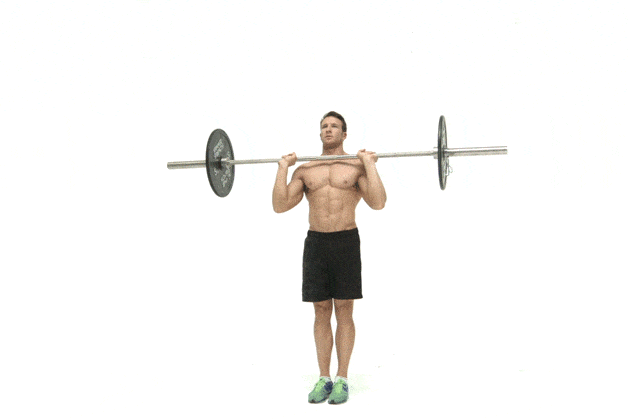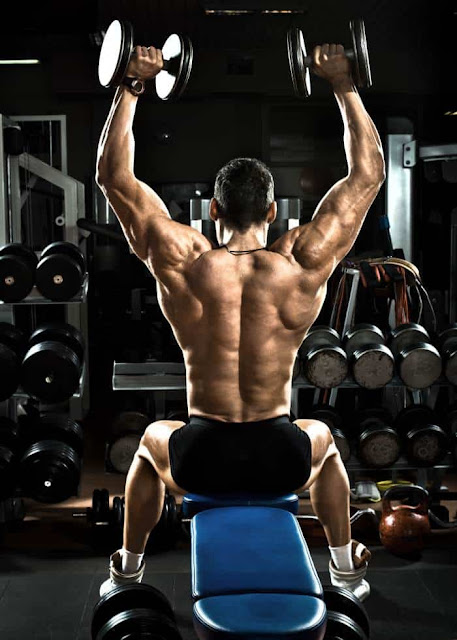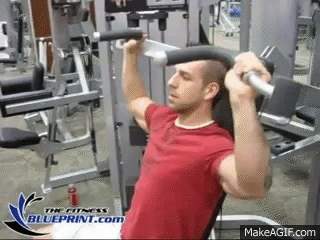What is a shoulder press?
The shoulder press is a compound resistance exercise which targets the deltoid muscles. It can be performed with a barbell, dumbbells or on a machine either in a standing or seated position. This is a great exercise for adding serious mass to your shoulders, traps, and triceps.
Which muscles are worked by the shoulder press?
Primarily, this exercise is used to develop the shoulders, but it also activates the triceps and trapezius muscles. If performed while standing, your abs and back muscles step in as stabilisers.
As you can see from the diagram above, the primary muscle worked is the front deltoid, with the lateral deltoids being brought in to assist. As with any pressing exercise, your triceps will be activated to straighten the arm. As the shoulders are squeezed together, your traps will be activated and take on some of the strain.
Benefits of using a shoulder press.
Bodybuilders will use an overhead press to promote growth in the upper body. It is one of the best upper body compound exercises for growing the deltoids, triceps, and traps. If you are training for strength, a shoulder press is a vital part of your routine.
It strengthens your shoulder muscles and stabiliser muscles for overhead presses. If you are training with a full body split, upper-lower split or PPL split, the overhead press should be the first exercise on your list.
The only downside to the overhead press is that it is one of the easiest exercises to gain an injury from. Your shoulders are under great strain if you lift heavy and there is a high risk of a rotator cuff injury. To help mitigate this risk, make sure that your shoulder joint and muscles are fully warmed up.
Spend a few minutes doing arm swings followed by some rotator cuff warm-ups with a light weight or resistance band.
When you start pressing, do a couple of sets with a light weight to make sure that there is blood in the muscle and you are fully prepared.
How to perform a standing barbell shoulder press.
The standing barbell shoulder press, also known as a military press, is a great compound exercise. It targets the shoulders, traps and triceps but your abs, back and quads are activated as stabilising muscles.
If training for hypertrophy, use a lighter weight that allows you to perform 10-15 reps for a few sets. Keep the rest periods short if you want a great pump. For strength, work your way up to a weight that you can only lift 4-6 times with strict form.
You can start with the barbell bar hanging by your hips and jerk it into the starting position by your chest, but the safest and easiest way is to use a rack.
Most racks are placed in front of mirrors which gives you the added benefit of making sure you are keeping a strict form.

- Load your bar onto a rack at shoulder height. Add the desired plates to your bar.
- Place your hands on the bar at shoulder width, arch your back, and move your body underneath by bending the elbows.
- Lift the bar from the rack and take a step back with the bar supported on your upper chest. This is your starting position.
- Take a deep breath. Upon exhale, press the bar above your head. Try not to lock your arms at the top of the movement.
- Once at the top of the movement, slowly lower the bar. You do not have to come down to the chest again, but at least bring the bar down to chin height.
- Repeat the movement for the required number of reps and sets.
It is a good idea to find your best grip width before adding weight to the bar. Perform a couple of warm-up sets with an empty bar and try a wider grip.
If it feels more comfortable and you feel a better connection with the muscle, use that wider grip.
Make sure that you are using a strict form and not bouncing the weight up by jerking your body. This means arching your back to start the movement and as the weight is lifted over your head, straighten your back and head.
The barbell press can also be performed in a seated position, but this is hard to do with a heavy weight. Most people will opt to use dumbbells if seated.
In contrast to this, the standing press can be performed using dumbbells. Switching to dumbbells means that your weaker arm is not being helped by your stronger arm and is getting a better workout.
How to perform a seated dumbbell press.
The seated dumbbell press is another way to work the shoulders with a compound, pressing movement. The main advantage to using a seated dumbbell press is that the stabiliser muscles are kept out of the movement and your spine is kept straight by the back of the seat.
A lot of lifters will opt to slightly incline the bench as it makes heavier lifts a bit easier. Keep in mind that the further you recline the bench, the more the chest will be activated and the lateral delts will be kept out of the movement.
To minimize chest involvement, keep the back of the bench in an upright position and use a strict, upright press or behind-the-neck press.
- Set up your bench so that the seat is flat and the backrest is fully upright.
- Select your weight and sit on the bench with your dumbbells resting on your knees.
- Swing your dumbbells up to the starting position level with your head. Use your legs to jerk the weights upwards to the starting position.
- Once you have the weights next to your head as shown in picture 1, take a deep breath.
- Upon exhale, extend your arms and lift the dumbbells in an upwards motion.
- Just before you lock out your arms, pause for a second and lower the weight to the starting position.
- Repeat for the required number of reps and sets.
When you have finished the movement, you may find it beneficial to drop the weight. This is frowned upon in some gyms, but if you try and place a heavy weight down on the floor without full control, you can cause an injury to your biceps, chest or shoulders.
Make sure that there is nobody close when you drop the weight; that your feet are out of the way; that you will not be dropping the weight on your phone, and that the floor is designed to take the shock. Most free weight areas in gyms are geared up for this with rubber matting and rubber dumbbells.
How to use a shoulder press machine.
Shoulder press machines are found in most commercial gyms and can be a great way to perform the movement in a safer manner.
The range of motion can be a bit narrower and the grip options may be restricted but a machine allows you to press the shoulders without the risk of dropping the weight and without engaging core stabiliser muscles.
Shoulder press machines can vary from gym to gym. Some are plate loaded while others use a weight stack for resistance. Some are forward-facing, some are backwards facing, and some have a rigid motion, while some have a 'hammer press' style motion.
All of them do the same thing, just from a slightly different angle. If your gym does not have a shoulder press machine, you could set up a bench in a smith machine with the same result.
The exercise is fairly self-explanatory. You simply adjust the seat level to a comfortable starting position, select your weight, and press the bar.
A shoulder press machine is a great place to start if you are a beginner as it takes the majority of the risk out of the exercise.









